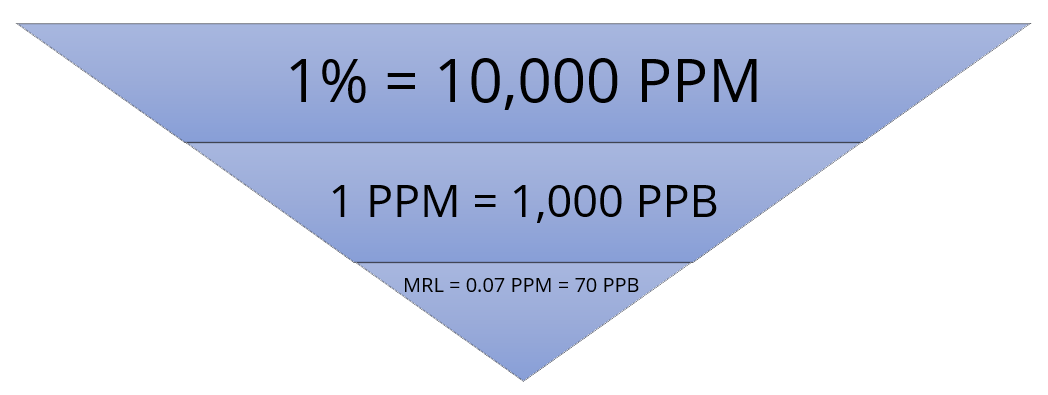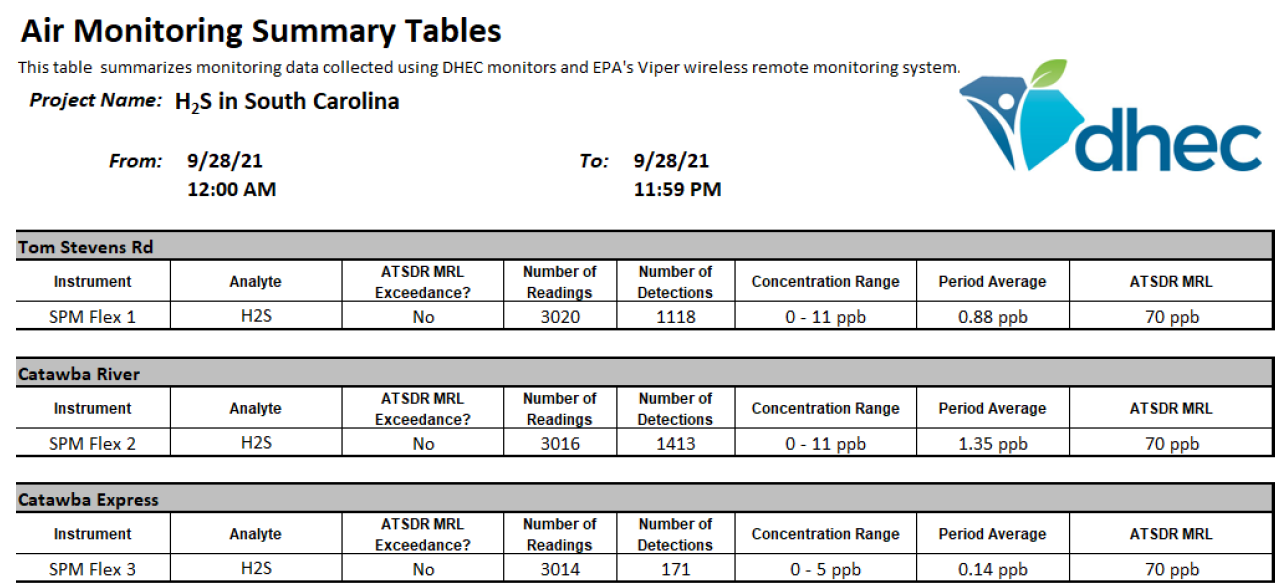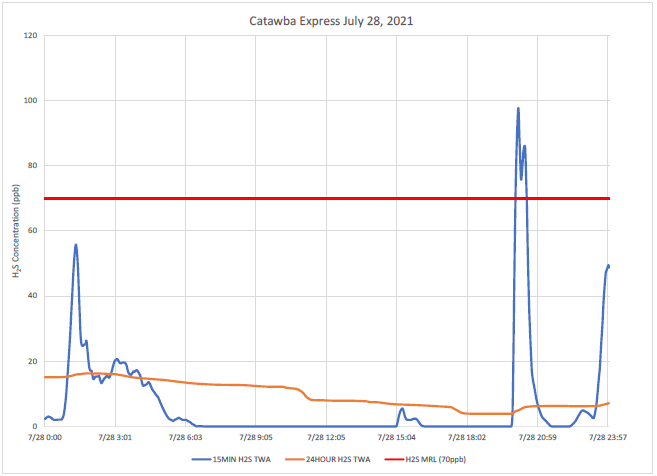While there are no regulatory exposure limits outside of the workplace for hydrogen sulfide (H2S), there are exposure guidelines to which any monitoring data will be compared. The Center for Disease Control and Prevention’s Agency for Toxic Substances and Disease Registry (ATSDR) has established an acute Minimal Risk Level (MRL) for H2S. A MRL is an estimate of the daily human exposure to a hazardous substance that is likely to be without appreciable risk of adverse health effects over a specified duration of exposure.1
The Acute MRL for continuous exposure from 1 day to 14 days is 0.07 parts per million (ppm), which is equal to 70 parts per billion (ppb). The daily monitoring reports will show one day (24 hour) time-weighted averages in parts per billion (ppb).
Part per billion (ppb) equivalents are shown on this page because other data related to this investigation has been expressed in these units. It is critical that the units of measurement between monitoring results and the exposure guidelines match. For example, both should be in either parts per million (ppm) or parts per billion (ppb). It is easy to convert one to the other. 1 ppm = 1000 ppb, so to go from ppm to ppb, multiply by 1000; and to go from ppb to ppm, divide by 1000.
It is important to understand units of measurement when looking at monitoring results. A part per billion (ppb) is the equivalent of a penny in a ten million dollars. See Table 1. Below for a perspective.

The instruments being used for the monitoring done by DHEC can measure down to 1 part per billion (ppb) up to 10 parts per million (ppm).
The odor threshold range for hydrogen sulfide is 0.0005 to 0.3 ppm (0.5 to 300 ppb).
Additional exposure guidelines: Acute Exposure Guideline Levels (AEGLs) were developed by the National Advisory Committee for Acute Exposure Guideline Levels for Hazardous Substances. These levels represent exposure limits for the general public for periods of time ranging from 10 minutes to 8 hours. Three levels – AEGL-1, AEGL-2 and AEGL-3 are established for each of five exposure time periods shown in the table below. Values are shown for concentration in both ppm and ppb.
Hydrogen Sulfide2
| Classification | 10 min | 30 min | 1 hour | 4 hour | 8 hour |
|---|---|---|---|---|---|
| AEGL-1 (Nondisabling) | 0.75 ppm 750 ppb |
0.60 ppm 600 ppb |
0.51 ppm 510 ppb |
0.36 ppm 360 ppb |
0.33 ppm 330 ppb |
| AEGL-2 (Disabling) | 41 ppm 41000 ppb |
32 ppm 32000 ppb |
27 ppm 27000 ppb |
20 ppm 20000 ppb |
17 ppm 17000 ppb |
| AEGL-3 | 76 ppm 76000 ppb |
59 ppm 59000 ppb |
50 ppm 50000 ppb |
37 ppm 37000 ppb |
31 ppm 31000 ppb |
1ATSDR Toxicological Profile on Hydrogen Sulfide: https://www.atsdr.cdc.gov/ToxProfiles/tp114-a.pdf
2AEGL for Hydrogen Sulfide: https://www.epa.gov/aegl/hydrogen-sulfide-results-aegl-program
How do I Interpret the Daily Reports?
At the top of each daily report you will find the date and the 24-hour time period for each report (midnight to midnight).
Notes about the monitoring period will be put at the top of the page. For example if a monitor failed (could be a battery issue or an issue with a sensor) or if an error was made in a report, this section will contain an explanation of the correction.
A map with locations of the facility as well as monitor locations is also part of each report. There will be a description of the prevailing wind direction during the monitoring period just before the charts.
Monitors operated by DHEC take a reading every 30 seconds - that is the Number of Readings. A detect is defined as a measurable concentration during one of those 30 second readings. There are columns in the report for number of readings and number of detections.
The graph below shows a peak around 1:30 AM at ~50 parts per billion. The 30-minute average level at which health effects are expected is 600 ppb (0.6 ppm) (See AEGL-1 description on the monitoring landing page.) The 70-ppb red line is not a health standard but is a level that indicates further investigatory actions are warranted. The peak concentration recorded about 7PM exceeded the level of the 70 ppb Standard, but for less than an hour.
The red line is the 24-hour exposure guideline to which monitoring results are compared. Exposure guidelines have two components, concentration AND time. See the Acute Exposure Guideline table on the air monitoring page for exposure guidelines over shorter time periods.
While we have seen brief periods of time with concentrations above the red line at several locations, we have not come close to exceeding the guideline over the time period used for comparison. The 70 ppb is an acute Minimum Risk Level (MRL) set by the Centers for Disease Control and Prevention as a level that warrants additional investigation should it be exceeded.
Wind Forecast
The daily Wind/Odor Forecast will be discontinued after the weekend forecast provided Friday, December 11. An authoritative hourly forecast is available from the National Weather Service for the area of the facility at this link.
DHEC Daily Reports
The current onsite monitoring reported by the facility and boundary monitoring conducted by DHEC have documented the significant reduction in concentrations of Hydrogen Sulfide (H2S) near the facility and the continued reduction in intensity, frequency, and duration of H2S concentrations near the facility. Since September,2021, there haven’t been any instantaneous detections of H2S at any of DHEC’s continuous monitors at the facility boundary above 10% of the level of the most protective Acute Exposure Guideline (AEGL). This doesn’t mean there will not be odors detected offsite; it means the concentrations are consistently well below published health and safety guidelines.
Since monitored concentrations have been well below these established guidelines and New Indy must continue to report results from their current monitoring and the additional monitoring required by the Order, DHEC will suspend facility boundary monitoring and reporting in mid-August, 2023 unless there is a change in activity at the facility. DHEC’s monitoring may resume if there is an increase in on-site monitored concentrations or a significant change in operations associated with potential odor sources.
- June 29, 2021
- June 30, 2021
- July 2021 Reports
- August 2021 Reports
- September 2021 Reports
- October 2021 Reports
- November 2021 Reports
- December 2021 Reports
- January 2022 Reports
- February 2022 Reports
- March 2022 Reports
- April 2022 Reports
- May 2022 Reports
- June 2022 Reports
- July 2022 Reports
- August 2022 Reports
- September 2022 Reports
- October 2022 Reports
- November 2022 Reports
- December 2022 Reports
- January 2023 Reports
- February 2023 Reports
- March 2023 Reports
- April 2023 Reports
- May 2023 Reports
- June 2023 Reports
- July 2023 Reports
- August 2023 Reports
- September 2023 Reports
- October 2023 Reports
- November 2023 Reports
- December 2023 Reports
- January 1, 2024
- January 2, 2024
- January 3, 2024
- January 4, 2024
- January 5, 2024
- January 6, 2024
- January 7, 2024
- January 8, 2024

